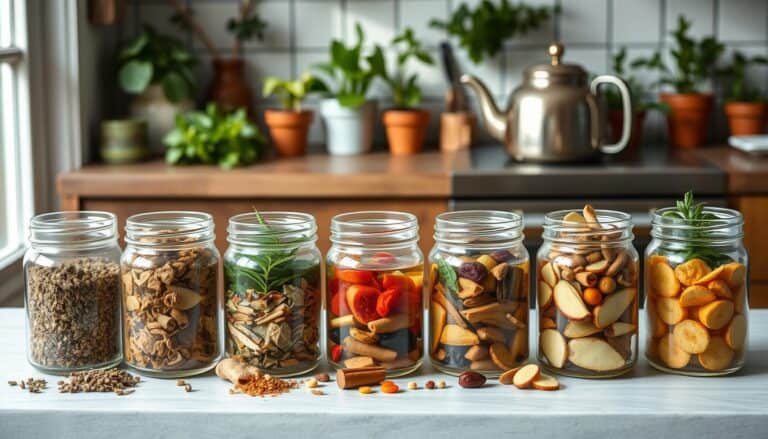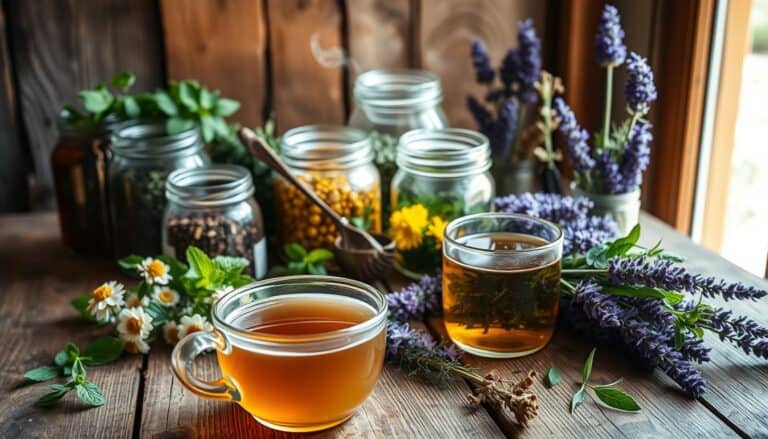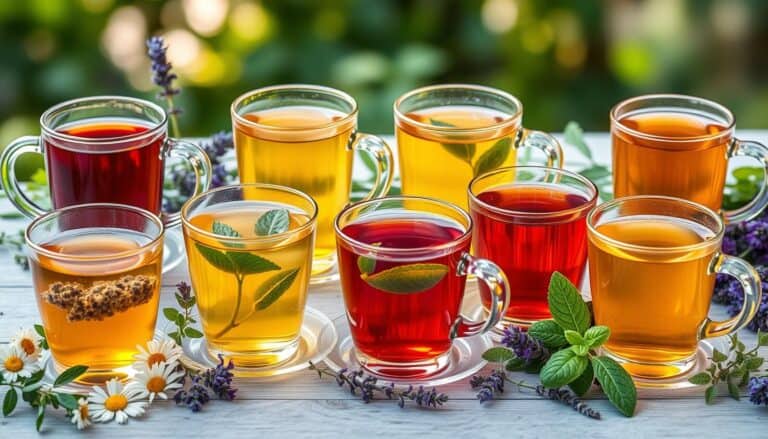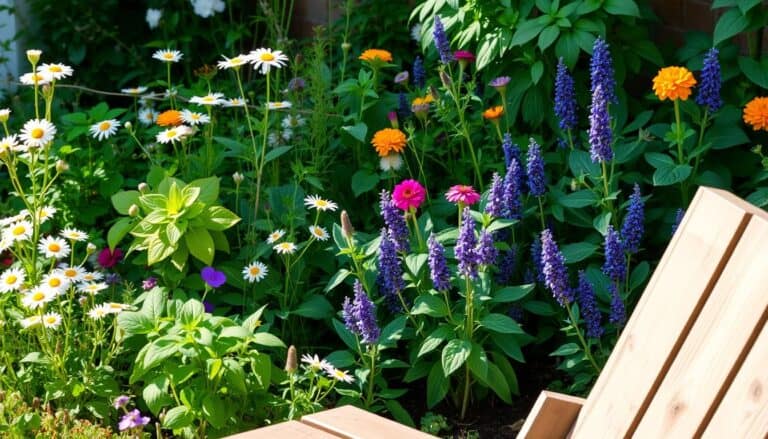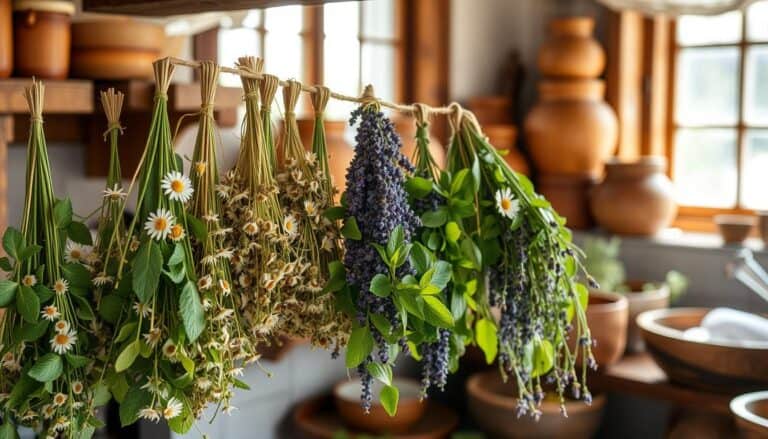Ultimate Guide to Creating Your Own Herbal Tea Blends
This post may contain affiliate links which means I may receive a commission for purchases made through links at no extra cost to you. I only recommend products I truly believe in. Thank you for your support!
Making your own herbal tea blends is like an art. It turns simple ingredients into healthful drinks. These natural ingredients do more than taste good; they help you relax and feel better.
Herbal tea blending lets you make drinks just for you. Want something to boost your immune system or ease stress? Learning about herbal tea recipes opens up a world of tasty options.
Starting your herbal tea adventure means learning a few basics. A good rule is to use 1 tablespoon of dried herbs for every 8 oz of water. Herbal experts say steep your blends for 15-20 minutes to get the most health benefits.
Tea experts use a special method to make their blends. They mix 3 parts of the main ingredient, 1-2 parts of a supporting one, and a small amount of an accent ingredient. This way, your tea will have a rich and balanced flavor.
Remember, always check with a doctor before trying new herbal teas for health reasons. Start with small amounts to test your blends. This way, you can find the perfect tea for you.
Introduction to Herbal Tea Blending
Herbal infusions are a fun way to explore natural wellness and taste. They are more than just drinks; they open doors to holistic health and sensory delights. By using dried herbs, we create therapeutic and tasty teas.
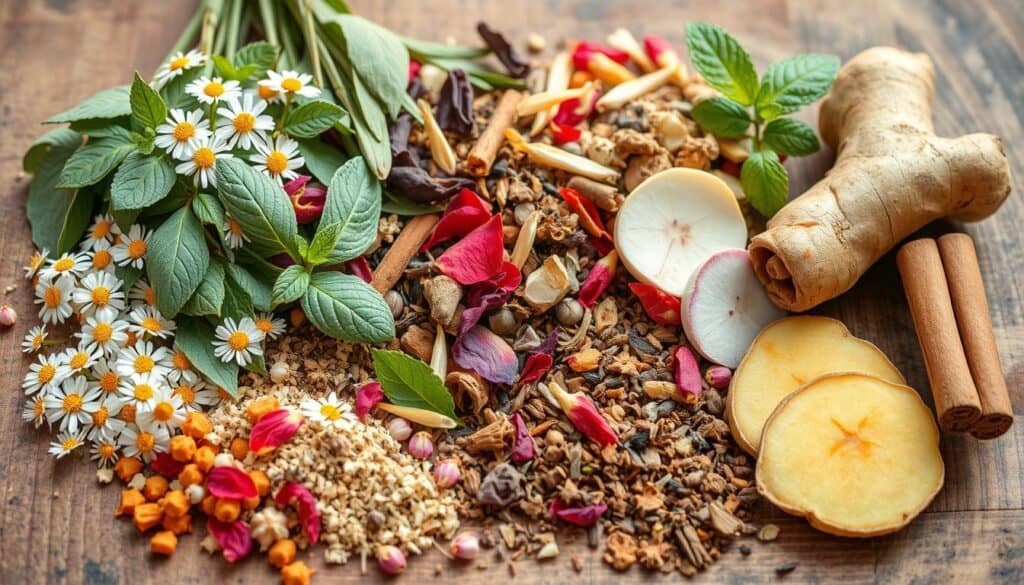
Herbal teas, or tisanes, are caffeine-free drinks made from plants like leaves, roots, flowers, and fruits. Unlike traditional teas, these blends offer unique tastes and health benefits.
Understanding Herbal Tea Basics
Making the perfect herbal tea blend is a three-step process:
- Primary herbs (70-80% of blend): They do the main work
- Supportive herbs (20-30%): They help the primary herbs
- Catalyst herbs (10%): They add flavor and extra benefits
Health Benefits of Herbal Teas
Each herbal blend has its own health benefits. For example, calendula fights inflammation and boosts the lymphatic system. Herbs like lemon balm and nettle can be turned into teas with healing powers.
The Art of Herbal Blending
Blending herbal teas is an art that requires knowledge of plant interactions and flavors. Use about 1-2 teaspoons of herbs per 150ml of hot water. Covering your cup traps oils, enhancing the tea’s health benefits.
Herbal tea blending is a great way to find relaxation, immune support, or a tasty drink. Start your journey with curiosity and a desire to try new things.
Essential Ingredients for Herbal Tea Blends
Making your own herbal tea blends is like creating a work of art. It starts with knowing the amazing world of herbs. Each herb adds its own special taste and health benefits. This turns a simple drink into a powerful way to feel better.
Common Herbal Ingredients
To make the best herbal tea blend, choose high-quality herbs. They should taste great and have health benefits. Here are some favorites:
- Echinacea – supports immune health
- Elderberries – rich in antioxidants
- Tulsi (Holy Basil) – stress-reducing properties
- Chamomile – promotes relaxation
- Peppermint – aids digestion
Choosing Quality Herbs
When picking herbs for your tea, go for organic and fresh. Look for herbs that are:
- Sourced from trusted suppliers
- Organic and free from pesticides
- Kept in airtight containers
- Picked recently
Additional Flavoring Options
Make your herbal tea even better with these flavor boosters:
| Ingredient | Flavor Profile | Recommended Quantity |
|---|---|---|
| Dried Ginger | Spicy, warming | 1/2 teaspoon per blend |
| Dried Fruits | Sweet, tangy | 1 teaspoon per blend |
| Cinnamon | Warm, sweet | 1/4 teaspoon per blend |
Pro tip: Begin with small amounts when trying new ingredients. This helps you find the perfect mix for your herbal tea.
Equipment Needed for Blending Herbal Teas
To make tasty homemade herbal tea mixes, you need the right tools. Learning how to blend teas starts with setting up a good workspace. This is where you’ll create your special herbal blends.
Must-Have Tools for Tea Blending
Every tea blend lover needs a few basic tools to start. These tools help you make tea mixes that taste great and are consistent:
- Measuring spoons for precise ingredient proportions
- Medium-sized mixing bowl for combining herbs
- Airtight glass jars with tight-fitting lids
- Waterproof labels for tracking blend details
- Mortar and pestle for grinding dried herbs
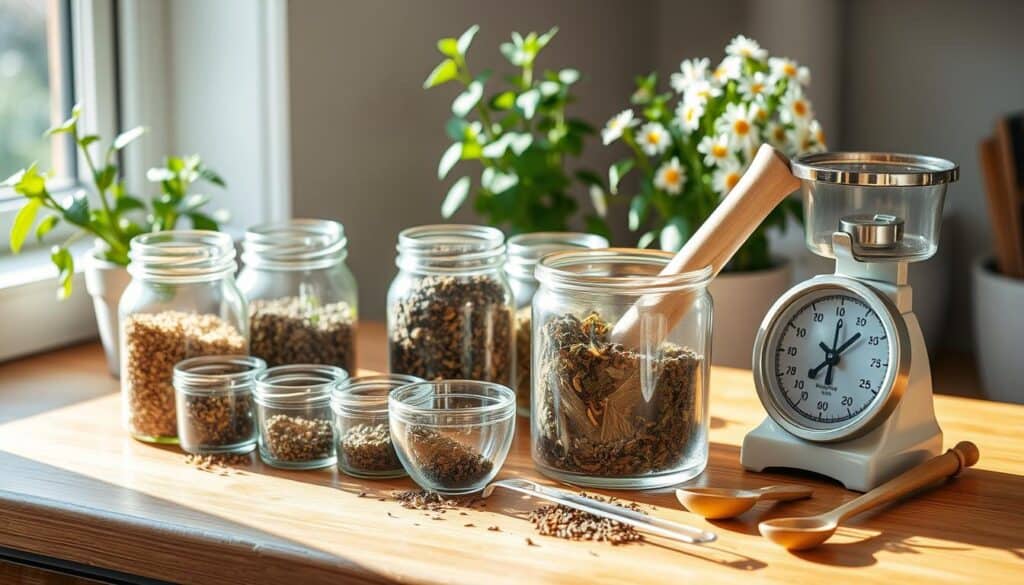
Optional Equipment for Enthusiasts
If you love tea blending, you might want some extra tools. These can make your tea-making even better:
| Equipment | Purpose |
|---|---|
| Digital Kitchen Scale | Ensure precise ingredient measurements |
| Reusable Tea Filters | Create custom brewing options |
| Dedicated Blending Workspace | Organize and streamline tea preparation |
Choose airtight glass jars for storing your herbal blends. Good storage keeps your tea fresh and potent. It’s key for keeping the flavors and health benefits of your tea mixes.
Understanding Flavor Profiles in Herbal Teas
Creating amazing herbal tea recipes needs a deep understanding of flavor complexity. The art of making customized herbal tea blends starts with knowing the unique tastes of different herbs and spices.

Our taste buds can tell five main tastes: sweet, sour, bitter, salty, and umami. Each herb adds its own special flavor to your tea blend. This creates a rich sensory experience that’s more than just taste.
Identifying Flavor Notes
Herbal teas offer a wide range of flavor experiences. Some common flavor descriptors include:
- Earthy: Rooted, deep flavors like mushroom or soil
- Floral: Delicate, perfumed notes from chamomile or lavender
- Fruity: Bright, sweet tastes from berries or citrus
- Spicy: Warm, intense flavors like ginger or cinnamon
Balancing Flavors for Optimal Taste
When making customized herbal tea blends, keep these flavor balance tips in mind:
| Flavor Category | Recommended Proportion | Example Herbs |
|---|---|---|
| Base Flavor | 70% | Chamomile, Rooibos |
| Complementary Flavor | 30% | Mint, Lavender |
| Accent Flavor | 10% | Ginger, Lemon Peel |
Try 1-3 herbs that naturally go well together. Use strong base herbs with bold flavors and lighter herbs with delicate notes. The secret to amazing herbal tea recipes is in the careful mix and tasting.
Step-by-Step Guide to Creating Your Blend
Making the perfect herbal tea recipes takes patience, creativity, and knowing how to blend teas. Your journey begins with learning a few key principles. These principles turn simple herbs into amazing drinks.
Experimenting with Ratios
When making herbal tea recipes, the right amounts are key. A common method is to use:
- 3 parts base ingredient
- 1-2 parts supporting herbs
- 1/4 to 1 part accent herbs
For instance, a winter blend might mix:
| Herb | Amount | Purpose |
|---|---|---|
| Anise Hyssop | 2 tablespoons | Base flavor |
| Echinacea | 2 tablespoons | Supporting wellness |
| Elderberries | 2 tablespoons | Immune support |
| Damiana | 1 tablespoon | Accent flavor |
Steeping Techniques
Learning how to blend teas also means knowing how to steep them right. Use 2 teaspoons of fresh herbs for every 6 ounces of boiling water. Fresh herbal teas steep for 5-10 minutes, while dried ones need 3-5 minutes.
Tasting and Adjusting Your Blend
The last step is tasting and tweaking your blend. Start by steeping 1 tablespoon of your mix in 8 ounces of hot water for 15-20 minutes. Check the flavor, aroma, and overall feel. Adjust the amounts as needed to get the taste you want.
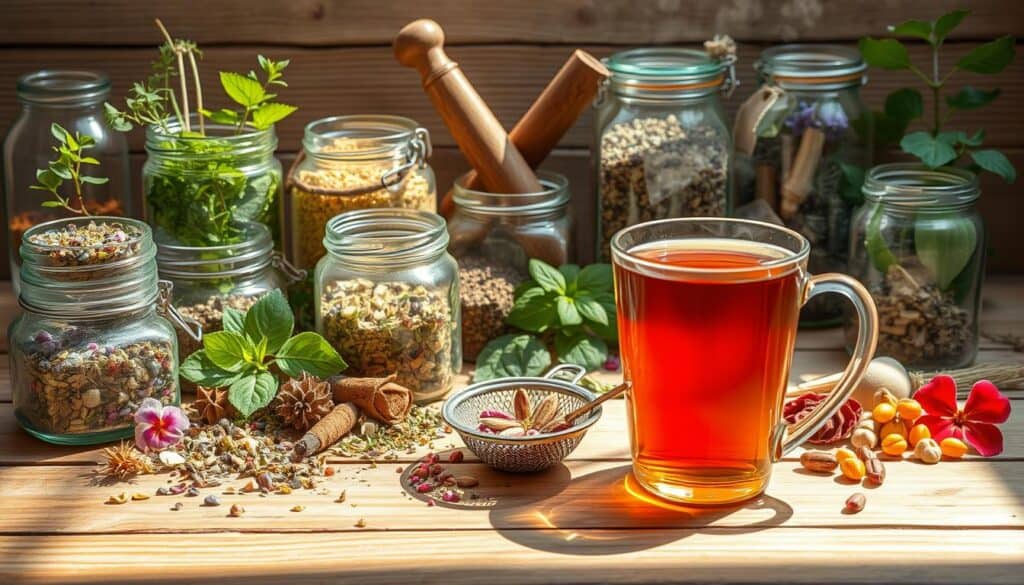
Popular Herbal Tea Blends to Inspire You
Making your own herbal tea mixes is a fun journey. It’s all about exploring flavors and wellness. Each blend offers a unique way to improve your health and relax.
Let’s look at three amazing herbal tea blends to spark your creativity:
Relaxing Chamomile Lavender Blend
This blend is all about calm. It mixes chamomile and lavender for a peaceful drink. The ingredients are:
- 2 teaspoons dried chamomile flowers
- 1 teaspoon dried lavender buds
- 1/2 teaspoon lemon balm leaves
This tea helps reduce stress and improve sleep. Steep for 5-7 minutes in hot water to get the most benefits.
Energizing Mint Ginger Mix
Looking for a natural energy boost? This blend is perfect. It includes:
- 1 teaspoon fresh peppermint leaves
- 1 teaspoon grated ginger root
- Optional: 1/2 teaspoon green tea leaves
Ginger and peppermint together boost energy and aid digestion. It’s a refreshing tea mix.
Immune-Boosting Echinacea Citrus Blend
Boost your immune system with this blend:
- 1 teaspoon dried echinacea
- 1/2 teaspoon elderberry
- Lemon verbena leaves
- Fresh orange peel
This mix strengthens your immune system with citrusy freshness. Drink it warm for better nutrient absorption.
Storing Your Herbal Tea Blends
Keeping your loose leaf herbal tea fresh is key. It helps keep the flavor and health benefits alive. The right storage keeps the delicate herbs fresh and strong.
Best Practices for Freshness
Storing herbal tea blends needs careful attention. The right storage method can make your dried herbs last longer and stay better quality.
- Choose airtight glass containers to prevent moisture and air exposure
- Store in a cool, dark place away from direct sunlight
- Maintain consistent temperature between 60-70°F
- Keep away from strong-smelling spices or foods that might transfer odors
Containers and Labeling Tips
Picking the right container for your loose leaf herbal tea is crucial. It helps keep the tea fresh and intact.
| Container Type | Pros | Best For |
|---|---|---|
| Glass Jars with Tight Lids | Prevents moisture, allows visibility | Most herbal tea blends |
| Ceramic Containers | Blocks light, maintains temperature | Delicate herb blends |
| Vacuum-Sealed Bags | Minimal air exposure | Long-term storage |
Make detailed labels for each blend. Include:
- Ingredients list
- Date of creation
- Recommended brewing time
- Suggested storage duration
When stored right, most herbal tea blends stay fresh for 6-12 months. Remember, fresh herbs taste better and offer more health benefits.
Conclusion: Embrace Your Creativity with Herbal Tea
Your journey through the Ultimate Guide to Creating Your Own Herbal Tea Blends is more than learning a new skill. It’s a dive into ancient traditions that connect us to tea lovers across cultures. You’ve explored a world of flavors, wellness, and creativity, from Asia’s rich tea heritage to modern herbal tea recipes.
Creating herbal tea blends is like an art form. It lets you express yourself while supporting your health. Whether you grow herbs in a small garden or try Organo Republic seeds, each blend has its own story. Making your own tea is more than just taste; it’s about connecting with nature and simplifying life.
Continuing Your Herbal Tea Journey
Remember, tea blending is a journey that keeps going. Start with easy herbs like chamomile, mint, and lemon balm. Try new recipes, mix different herbs, and listen to your taste. Your herbal tea journey celebrates creativity, wellness, and the tradition of tea making.
Resources and Communities for Herbal Enthusiasts
Explore more of the herbal tea world by meeting local herbalists, joining online groups, and going to tea workshops. Your knowledge of herbal tea recipes is just the start of a fun and nourishing journey for your body and spirit.


